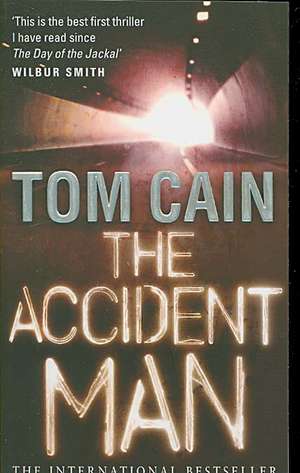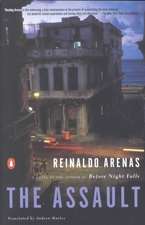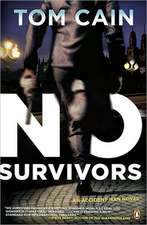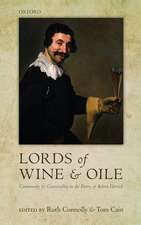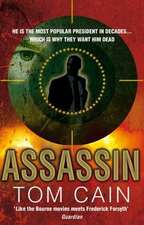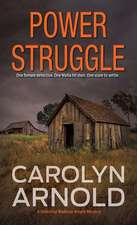The Accident Man. Tom Cain
Autor Tom Cainen Limba Engleză Paperback – 2008
| Toate formatele și edițiile | Preț | Express |
|---|---|---|
| Paperback (2) | 124.72 lei 3-5 săpt. | |
| Penguin Books – 31 ian 2009 | 124.72 lei 3-5 săpt. | |
| Transworld Publishers Ltd – 2008 | 130.35 lei 3-5 săpt. | +11.68 lei 5-11 zile |
Preț: 130.35 lei
Nou
Puncte Express: 196
Preț estimativ în valută:
24.95€ • 25.95$ • 20.59£
24.95€ • 25.95$ • 20.59£
Carte disponibilă
Livrare economică 24 martie-07 aprilie
Livrare express 08-14 martie pentru 21.67 lei
Preluare comenzi: 021 569.72.76
Specificații
ISBN-13: 9780552155359
ISBN-10: 0552155357
Pagini: 553
Dimensiuni: 109 x 178 x 41 mm
Greutate: 0.28 kg
Editura: Transworld Publishers Ltd
Locul publicării:United Kingdom
ISBN-10: 0552155357
Pagini: 553
Dimensiuni: 109 x 178 x 41 mm
Greutate: 0.28 kg
Editura: Transworld Publishers Ltd
Locul publicării:United Kingdom
Notă biografică
Tom Cain
Descriere
Samuel Carver is a good guy who makes bad things happen to bad people. He is called to do a hit at very short notice. When he discovers the identity of his target, and the identity of the target's companion, he knows that his life is over. This is a secret too big to let him live, unless he can track down the real villains before they get to him.
Recenzii
"A thrill-a-minute debut. . . . Cain gets high marks for a creative yet easily believable story line that only adds fuel to the fire about what really happened to Diana."
-USA Today
"An adrenaline-fueled thriller that doesn't stoop to prurient gimmicks. . . . Cain keeps the scenery breathtaking and the action heart-stopping."
-The Philadelphia Inquirer
"This is the best first thriller I have read since The Day of the Jackal, and that was a long time ago. With one mighty bound, Tom Cain has vaulted over Archer and Grisham and stands close on Fredrick Forsyth's tail."
-Wilbur Smith
-USA Today
"An adrenaline-fueled thriller that doesn't stoop to prurient gimmicks. . . . Cain keeps the scenery breathtaking and the action heart-stopping."
-The Philadelphia Inquirer
"This is the best first thriller I have read since The Day of the Jackal, and that was a long time ago. With one mighty bound, Tom Cain has vaulted over Archer and Grisham and stands close on Fredrick Forsyth's tail."
-Wilbur Smith
Extras
The time was a quarter-past midnight. Samuel Carver stood astride the Honda, waiting to go into action. He glanced down at the black metal tube, clipped to the bike behind his right leg. It looked like a regular, long-barrelled flashlight, the kind that police or security guards use. It was, in fact, a portable diode pump laser, otherwise known as a dazzler. Developed as a non-fatal weapon for US police forces, but taken up with deadly enthusiasm by special forces around the world, it emitted a green-light beam at a frequency of 532 nanometers. Its nickname, though, was misleading. When this light shone in somebody's eyes, they weren't just dazzled. They were incapacitated.
A green-laser beam left anyone who looked at it disoriented, confused and temporarily immobile. The human brain couldn't process the sheer amount of light data flooding through the optic nerves. So it acted like any other overloaded computer. It crashed.
Night or day, rain or shine, a dazzler was an accident's best friend.
It would only be a matter of seconds now. Carver was positioned by the exit of an underpass that ran beneath an embankment on the northern side of the Seine. If he turned his head fractionally to the right, he could look across the river at the glittering spire of the Eiffel Tower darting up into the night sky. It was past midnight, but there were still a few pleasure-boats out on the water. If Carver had been the slightest bit interested, he'd have seen the lovers standing arm inarm by the rails, looking out at the City of Light. But Carver had other things to think about. He was looking towards the far side of the underpass. All he cared about was the traffic.
The time had come. He took a deep breath, then let the air out slowly, dropping his shoulders, easing the muscles, twisting his neck and rotating his head to loosen the top of his spinal cord. Then he looked back at the road.
Several hundred metres away, beyond the entrance of the underpass, he saw a black Mercedes. It was travelling fast. Way too fast.
Behind the Merc was the reason for its desperate speed. A motorbike was chasing it, buzzing around the big black car like a wasp around a buffalo. There was a passenger riding pillion, carrying a camera, leaning away from his seat and firing his flashgun, apparently oblivious to his own safety. He looked for all the world like a paparazzo, risking his neck for an exclusive shot.
'Nice work,' thought Carver, watching the speed team doing their job. He started his bike and got ready to move.
For a second, he imagined the passengers in the car, urging their driver to pull away from the relentless pursuit of the bike.
Everything was going to plan. Carver rolled downhill, towards the road leading from the underpass.
As he reached the junction with the main road, a grey Citroen BX hatchback emerged from the underpass. Carver let it go, noting the two Arab men in the driver's and passenger's seats. Another car went by, a Ford Ka. Then Carver rode his bike out into the middle of the road.
He crossed to the far side of the carriageway, then turned the Honda into the flow of the oncoming traffic and dashed forward about a hundred metres to the mouth of the underpass. There was a line of pillars down the middle of the road. They supported the tunnel roof and separated the two directions of traffic. He stopped by the last pillar and reached down to unclip his dazzler.
Something caught Carver's eye.
At the mouth of the underpass, coming towards him, was a battered white Fiat Uno. It was doing the legal speed, 50 kilometres per hour, and therefore going less than half as fast as the car and bike racing towards its tail.
Carver's eyes narrowed as he pulled out the laser. His mouth gave a quick twitch of silent irritation. This wasn't part of the plan.
The Mercedes and the motorbike were closing on the little white car at breakneck speed. There were a hundred metres between them. Fifty. Twenty.
The Merc came roaring up behind the Fiat in the right hand lane, then swung left, trying to overtake it. The bike-rider had no option. He had to go round the other way, squeezing between the right-hand side of the Fiat and the tunnel wall. Somehow, he shot through without a scratch, rocketing out the far side of the Fiat.
The Merc wasn't so lucky. The front of the car, on the passenger's side, caught the Fiat from behind. The Merc smashed through the Fiat's rear lights and crumpled the thin metal of the Fiat's rear panels.
The tunnel walls echoed to the cacophony of screaming engines, smashing plastic and tortured metal. But inside his helmet, Carver felt isolated, unaffected by the chaos that was rushing towards him. He could see the driver of the Mercedes struggling to regain control as his vehicle careered across the road. The guy was good. Somehow the car straightened out. Now it was coming straight towards Carver.
Carver stood as immobile as a matador facing a charging black bull. He raised the laser, aimed at the windscreen of the car and pressed the switch.
The blast of light was instantaneous. A beam of pure energy exploded across the ever-narrowing gap between Carver and the onrushing Merc. It took only a fraction of a second then the beam was gone.
The Mercedes lurched to the left. Somewhere, deep in the unconscious, animal part of the driver's brain, some sort of alarm signal must have registered. He slammed his foot on the brakes, desperately trying to stop the car.
He had no chance. The two-ton Mercedes smashed into one of the central pillars, instantly decelerating from crazy speed to total immobility. But there was just too much speed, too much weight, too much momentum. The shattered car bounced off the pillar and slewed across the road, spinning round as it went. It finally came to a halt in the middle of the road, facing back the way it had just come.
The front of the Merc looked like a Dinky toy hit by a baseball bat, with a gigantic U-shaped depression where the bonnet and engine-bay had been. The windscreen was shattered, as was every other window. The driver's-side front wheel had splayed out from the side. On the other side, the wheel had been jammed into the bodywork. The roof had been ripped from the passenger side, jammed down into the passenger compartment and shifted two feet to the left. The pressure from front and top had forced all four doors open.
There was no sign of movement from the passenger compartment. Carver knew that the chances of anyone surviving that kind of an impact were minimal. In the corner of his eye he saw a car drive past him, on the other side of the road, going into the tunnel, past the Mercedes.
Meanwhile, the Fiat was completing its journey out of the tunnel. Carver caught a glimpse of shock and terror on the driver's face. Then he noticed something else. There was a dog in the front seat. It had its tongue out, panting happily, oblivious to the destruction disappearing behind it.
Carver strapped the laser back on the petrol-tank of his bike. He was tempted to go down and check the wreckage to make sure the target was dead, but there was little point. In the unlikely event that anyone had survived such a devastating impact, there was nothing Carver could do about it without leaving some sort of forensic trace. And even if Ramzi Hakim Narwaz was still alive, he wasn't going to be plotting terrorist activities any time soon.
It was time to go. At the far end of the tunnel, Carver could see a couple of pedestrians, standing and watching, unable to decide whether to walk any further towards the scene of the accident. In the distance he could hear the mosquito whine of motorbike engines. People were coming. They would have cameras. They would be followed by cops, ambulances, fire engines.
Carver didn't want to be around when they got there. He needed to get away before anyone figured out that this wasn't just an unfortunate accident. He swung the tail of his bike round 180 degrees and headed back up the exit ramp of the Alma Tunnel.
A green-laser beam left anyone who looked at it disoriented, confused and temporarily immobile. The human brain couldn't process the sheer amount of light data flooding through the optic nerves. So it acted like any other overloaded computer. It crashed.
Night or day, rain or shine, a dazzler was an accident's best friend.
It would only be a matter of seconds now. Carver was positioned by the exit of an underpass that ran beneath an embankment on the northern side of the Seine. If he turned his head fractionally to the right, he could look across the river at the glittering spire of the Eiffel Tower darting up into the night sky. It was past midnight, but there were still a few pleasure-boats out on the water. If Carver had been the slightest bit interested, he'd have seen the lovers standing arm inarm by the rails, looking out at the City of Light. But Carver had other things to think about. He was looking towards the far side of the underpass. All he cared about was the traffic.
The time had come. He took a deep breath, then let the air out slowly, dropping his shoulders, easing the muscles, twisting his neck and rotating his head to loosen the top of his spinal cord. Then he looked back at the road.
Several hundred metres away, beyond the entrance of the underpass, he saw a black Mercedes. It was travelling fast. Way too fast.
Behind the Merc was the reason for its desperate speed. A motorbike was chasing it, buzzing around the big black car like a wasp around a buffalo. There was a passenger riding pillion, carrying a camera, leaning away from his seat and firing his flashgun, apparently oblivious to his own safety. He looked for all the world like a paparazzo, risking his neck for an exclusive shot.
'Nice work,' thought Carver, watching the speed team doing their job. He started his bike and got ready to move.
For a second, he imagined the passengers in the car, urging their driver to pull away from the relentless pursuit of the bike.
Everything was going to plan. Carver rolled downhill, towards the road leading from the underpass.
As he reached the junction with the main road, a grey Citroen BX hatchback emerged from the underpass. Carver let it go, noting the two Arab men in the driver's and passenger's seats. Another car went by, a Ford Ka. Then Carver rode his bike out into the middle of the road.
He crossed to the far side of the carriageway, then turned the Honda into the flow of the oncoming traffic and dashed forward about a hundred metres to the mouth of the underpass. There was a line of pillars down the middle of the road. They supported the tunnel roof and separated the two directions of traffic. He stopped by the last pillar and reached down to unclip his dazzler.
Something caught Carver's eye.
At the mouth of the underpass, coming towards him, was a battered white Fiat Uno. It was doing the legal speed, 50 kilometres per hour, and therefore going less than half as fast as the car and bike racing towards its tail.
Carver's eyes narrowed as he pulled out the laser. His mouth gave a quick twitch of silent irritation. This wasn't part of the plan.
The Mercedes and the motorbike were closing on the little white car at breakneck speed. There were a hundred metres between them. Fifty. Twenty.
The Merc came roaring up behind the Fiat in the right hand lane, then swung left, trying to overtake it. The bike-rider had no option. He had to go round the other way, squeezing between the right-hand side of the Fiat and the tunnel wall. Somehow, he shot through without a scratch, rocketing out the far side of the Fiat.
The Merc wasn't so lucky. The front of the car, on the passenger's side, caught the Fiat from behind. The Merc smashed through the Fiat's rear lights and crumpled the thin metal of the Fiat's rear panels.
The tunnel walls echoed to the cacophony of screaming engines, smashing plastic and tortured metal. But inside his helmet, Carver felt isolated, unaffected by the chaos that was rushing towards him. He could see the driver of the Mercedes struggling to regain control as his vehicle careered across the road. The guy was good. Somehow the car straightened out. Now it was coming straight towards Carver.
Carver stood as immobile as a matador facing a charging black bull. He raised the laser, aimed at the windscreen of the car and pressed the switch.
The blast of light was instantaneous. A beam of pure energy exploded across the ever-narrowing gap between Carver and the onrushing Merc. It took only a fraction of a second then the beam was gone.
The Mercedes lurched to the left. Somewhere, deep in the unconscious, animal part of the driver's brain, some sort of alarm signal must have registered. He slammed his foot on the brakes, desperately trying to stop the car.
He had no chance. The two-ton Mercedes smashed into one of the central pillars, instantly decelerating from crazy speed to total immobility. But there was just too much speed, too much weight, too much momentum. The shattered car bounced off the pillar and slewed across the road, spinning round as it went. It finally came to a halt in the middle of the road, facing back the way it had just come.
The front of the Merc looked like a Dinky toy hit by a baseball bat, with a gigantic U-shaped depression where the bonnet and engine-bay had been. The windscreen was shattered, as was every other window. The driver's-side front wheel had splayed out from the side. On the other side, the wheel had been jammed into the bodywork. The roof had been ripped from the passenger side, jammed down into the passenger compartment and shifted two feet to the left. The pressure from front and top had forced all four doors open.
There was no sign of movement from the passenger compartment. Carver knew that the chances of anyone surviving that kind of an impact were minimal. In the corner of his eye he saw a car drive past him, on the other side of the road, going into the tunnel, past the Mercedes.
Meanwhile, the Fiat was completing its journey out of the tunnel. Carver caught a glimpse of shock and terror on the driver's face. Then he noticed something else. There was a dog in the front seat. It had its tongue out, panting happily, oblivious to the destruction disappearing behind it.
Carver strapped the laser back on the petrol-tank of his bike. He was tempted to go down and check the wreckage to make sure the target was dead, but there was little point. In the unlikely event that anyone had survived such a devastating impact, there was nothing Carver could do about it without leaving some sort of forensic trace. And even if Ramzi Hakim Narwaz was still alive, he wasn't going to be plotting terrorist activities any time soon.
It was time to go. At the far end of the tunnel, Carver could see a couple of pedestrians, standing and watching, unable to decide whether to walk any further towards the scene of the accident. In the distance he could hear the mosquito whine of motorbike engines. People were coming. They would have cameras. They would be followed by cops, ambulances, fire engines.
Carver didn't want to be around when they got there. He needed to get away before anyone figured out that this wasn't just an unfortunate accident. He swung the tail of his bike round 180 degrees and headed back up the exit ramp of the Alma Tunnel.
